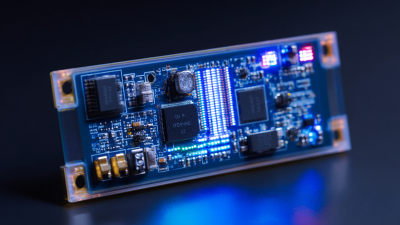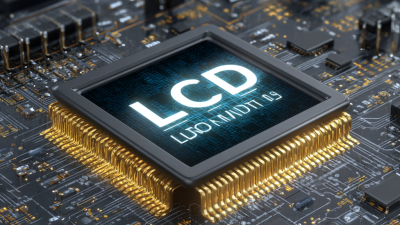Leave Your Message
The adoption of LCD Module technology has revolutionized display solutions across various industries, enabling significant advancements in performance, efficiency, and design flexibility. According to a recent report by MarketsandMarkets, the global LCD market is expected to reach a staggering value of $120 billion by 2026, growing at a compound annual growth rate (CAGR) of 6.2% from 2021. This growth can be attributed to the increasing demand for high-quality displays in consumer electronics, automotive applications, and industrial machinery. LCD Modules offer notable advantages, such as lower power consumption, thinner profiles, and improved image quality, making them ideal for modern applications where space and power efficiency are critical. This article will provide insights into how to effectively leverage LCD Module technology for various display needs, highlighting their unique benefits and practical implementation strategies in contemporary design practices.

LCD module technology has emerged as a pivotal player in modern display solutions, offering numerous advantages over traditional display technologies. The recent discussions at the DTS 2025 seminar highlighted how LCD modules excel in various applications, particularly due to their robust performance and versatility. Unlike older technologies, LCD modules provide enhanced brightness and improved color accuracy, making them suitable for demanding environments where visibility is crucial.
Tips: When considering an upgrade to LCD technology, evaluate the specific needs of your application, such as display size and environmental conditions. It's also beneficial to analyze energy consumption, as LCD modules generally offer better efficiency compared to their predecessors.
Moreover, the adaptability of LCD modules across different sectors—ranging from consumer electronics to automotive displays—reinforces their significance in today's display market. As identified in industry reports, trends indicate a steady growth trajectory for LCD technology, which can cater to both high-end displays and everyday devices.
Tips: Stay informed on emerging trends and technologies in the display industry, as innovation continues to shape the market landscape. Regularly assess performance metrics and consider how advancements like LCD can enhance user experience across your devices.
| Application | LCD Module Advantages | Traditional Display Limitations |
|---|---|---|
| Consumer Electronics | Thin profile, lightweight, energy-efficient | Bulky designs, higher power consumption |
| Industrial Displays | Wide operating temperature range, rugged performance | Limited temperature tolerance, less durability |
| Medical Devices | High resolution, precise color representation | Lower resolution, inaccurate color reproduction |
| Automotive Displays | Better visibility in sunlight, custom designs | Glare issues, limited customization |
| Public Information Displays | Versatile viewing angles, modular options | Narrow viewing angles, fixed sizes |
The display industry is witnessing significant growth, particularly in LCD module technology, driven by a variety of key factors. One major reason is the rising demand for high-resolution screens across multiple sectors, including healthcare and commercial applications. The global LCD panel market is projected to expand from USD 100.40 billion in 2025 to USD 192.40 billion by 2033, with a compound annual growth rate (CAGR) of 8.47%. This growth reflects an increasing reliance on LCDs for both standard and specialized display needs, such as medical imaging, where clarity and accuracy are paramount.
Tips for Industry Professionals: Focus on improving the energy efficiency of LCD modules to attract eco-conscious consumers and reduce operational costs. Additionally, consider integrating advanced technologies such as touch capabilities and enhanced color fidelity to meet the evolving expectations of customers in various sectors. Engaging in continuous market research will enable companies to adapt to changing trends and maintain a competitive edge.
Furthermore, the demand for responsive and adaptive display solutions is accelerating the adoption of LCD technology. Not only are consumers looking for vibrant and clear images, but they also want displays that can seamlessly integrate with smart technologies. This push for innovation in LCD modules presents a unique opportunity for manufacturers to invest in R&D, ensuring their products can cater to the diverse and growing market needs.
The power consumption of display technologies is a critical factor in the selection of an optimal solution for various applications, particularly in mobile devices and consumer electronics. LCD (Liquid Crystal Display) modules have shown significant advantages in this area when compared to alternatives such as OLED (Organic Light Emitting Diodes) and traditional CRT (Cathode Ray Tube) displays. While OLED screens offer vibrant colors and deeper blacks, they tend to consume more power, especially when displaying bright images, as each pixel is self-illuminating. In contrast, LCD modules utilize a backlight to illuminate pixels, resulting in generally lower power usage during standard operating conditions.
Moreover, the efficiency of LCD technology is particularly evident in environments where extended battery life is essential. For example, devices such as smartphones, tablets, and laptops can leverage the advantageous power consumption of LCDs, providing longer usage times without requiring frequent recharges. This makes LCD modules a preferred choice for manufacturers aiming to enhance user experience through sustainability and accessibility. As advancements in LCD technology continue to progress, the gap in power efficiency compared to other display options may further widen, underscoring the importance of this technology in shaping future display solutions.
Modern LCD module technology has brought a significant leap in user experience, particularly through enhancements in color accuracy and resolution. As consumer demand for visually immersive experiences continues to grow, high-quality displays are becoming paramount. According to recent industry research, the global LCD market is projected to reach $130 billion by 2025, driven by advancements in display resolution and innovative features like touch and foldable displays. These developments enable applications in areas ranging from education to professional presentations, engaging users with vibrant visuals.
Tips: To fully benefit from advanced LCD technologies, consider calibrating your display regularly to maintain optimal color accuracy. Utilizing software tools specifically designed for display calibration can ensure that colors appear true to life, enhancing the overall viewing experience.

As we explore the future trends in LCD module technology, it's clear that innovations are set to redefine display solutions across various industries. One of the most significant advancements is the integration of Mini LED technology, which offers unparalleled brightness and improved color accuracy. With LED chip sizes ranging from 50 to 200 micrometers, Mini LEDs enhance traditional LCD displays by enabling finer pixel pitches and better contrast ratios, making them ideal for high-performance applications.
Additionally, upcoming trends in display technology are being showcased at events like CES 2024, where manufacturers are unveiling cutting-edge solutions that incorporate smart technology and advanced features. The emphasis is on creating immersive experiences through enhanced display capabilities, such as adaptive refresh rates and increased durability. As the demand for sophisticated and versatile display systems continues to grow, the advancements in LCD technology, including application-specific innovations, will play a crucial role in shaping the future of visual communication across sectors like automotive, retail, and advertising.







